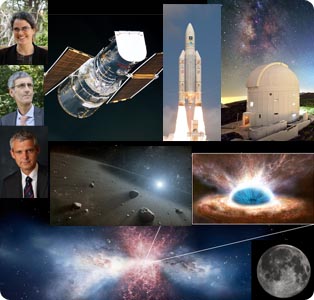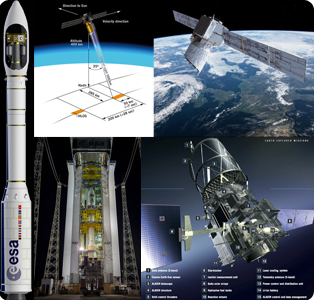International Astronomical Union Meets in Vienna for 30th General Assembly
IAU to host 30th General Assembly, having held one every 3 years since 1919 to advance scientific research, at Austria Center Vienna August 20-31. Over 3000 participants from 89 countries are expected to participate in this 2-week program. The Assembly is organized by Universität Wien, Austrian Society for Astronomy and Astrophysics (ÖGA2), and Austrian Academy of Sciences (ÖAW). The event is set to open with a special session featuring Andrea Ghez of UCLA and Frank Eisenhauer of Max Planck Institute discussing general relativity near and around the Galactic Center black hole. Heino Falcke of Radboud University to present on the Jet-Disk Model for the Galactic Center. Focus Meeting 14 on global astronomy outreach will include a poster by ILOA on Astronomy from the Moon. In other sessions, Xuelei Chen and Yan Su of National Astronomical Observatories of China to present posters on low frequency radio astronomy from Lunar orbit interferometer and from Chang’e-4 Lunar lander, respectively. Universität Wien Institute for Astrophysics Director Bodo Ziegler is co-organizing a mini-symposium on Build-Up of Galaxy Clusters. Other session topics include light pollution (including documentary screening), gravitational waves, galaxy evolution, and Hubble Space Telescope. Limited seating Women in Astronomy segments advocates advancement of women in science, while Inspiring Stars session scheduled to present inaugural event for a world exhibition promoting inclusive initiatives. (Image Credits: UCLA, MPE, ASTRON, ESA, NASA; Pictured: Andrea Ghez, Frank Eisenhauer, Heino Falcke) |
MONDAY
|

![]() = All times
= All times
for terrestrial events in local time unless noted.
![]() = All times for international terrestrial events in local time unless noted.
= All times for international terrestrial events in local time unless noted.
![]() = All times for space events, and…
= All times for space events, and…
![]() = All times for international space / astro events in Hawaii Standard Time unless noted. Add 10 hours to obtain UT (‘Universal Time’).
= All times for international space / astro events in Hawaii Standard Time unless noted. Add 10 hours to obtain UT (‘Universal Time’).
Weekly Planet Watch – Evening Planets: Venus (W), Mars (SE), Jupiter (SW), Saturn (S); Morning Planets: Uranus (E), Neptune (SE).
Arianespace, ESA to Launch Aeolus First Daily Global Wind Profile Satellite Aug 21
Arianespace 5th launch of 2018 will be 12th overall Vega flight, designated VV12, from Kourou French Guiana Aug 21 set to deploy ADM-Aeolus satellite. ADM-Aeolus, named after Greek mythology appointed “keeper of the winds”, will be the first satellite to deliver daily global wind profiles in an inaugural wind mission and 4th Earth Explorer mission within ESA Living Planet Programme, collecting ~120 profiles per hour. Liftoff to satellite separation is expected at ~55 minutes before ADM-Aeolus reaches Sun-synchronous orbit at an altitude of ~320 km for a designed 3-year operational life. The satellite is a single, real-time doppler wind LIDAR (light and radar) termed Aladin, Atmospheric Laser Doppler Instrument, a laser system which accurately measures global wind profiles from space by sending ultraviolet laser pulses through the lowermost 30 km of atmosphere and collecting backscattered light with a 1.5-meter telescope. Data from ADM-Aeolus could enhance understanding and forecasting of weather and climate change research. The 4.6-meter tall satellite comprised of platform, propellant, and payload has a total dry mass of 1,100-kg. This launch could become 50th mission and 8th Earth observation lofted by Arianespace for ESA. Vega stands at ~30-meters tall and has a mass of 137 metric tons. With another 9 upcoming Vega and Vega C launches planned thus far, one-third are scheduled for ESA missions. (Image Credits: Arianespace, ESA) |
Continued from…
TUESDAY
|
WEDNESDAY
![]() Aug 22 — Mauna Kea Visitor Information Station, Mauna Kea HI (2,800 meters): Star Gazing program, 18:00 22:00, weather permitting, free.
Aug 22 — Mauna Kea Visitor Information Station, Mauna Kea HI (2,800 meters): Star Gazing program, 18:00 22:00, weather permitting, free.
![]() Aug 22 — Moon: 1.4° N of Pluto, 09:00.
Aug 22 — Moon: 1.4° N of Pluto, 09:00.
![]() Aug 22 — Apollo Asteroid 2018 PK9: Near-Earth Flyby (0.044 AU)
Aug 22 — Apollo Asteroid 2018 PK9: Near-Earth Flyby (0.044 AU)
![]() Aug 22 — Aten Asteroid 2015 QM3: Near-Earth Flyby (0.063 AU)
Aug 22 — Aten Asteroid 2015 QM3: Near-Earth Flyby (0.063 AU)
THURSDAY
![]() Aug 23 — Cuyahoga Valley Space Society Chapter of National Space Society, Parma OH: Monthly meeting of Cuyahoga Valley Space Society; at Parma Library, 18:45-20:45.
Aug 23 — Cuyahoga Valley Space Society Chapter of National Space Society, Parma OH: Monthly meeting of Cuyahoga Valley Space Society; at Parma Library, 18:45-20:45.
![]() Aug 23-26 — The Mars Society, Pasadena CA: 21st Annual International Mars Society Convention; to talk about latest scientific discoveries, technological advances and political-economic developments that could help pave the way for a human mission to Mars; at Pasadena Convention Center.
Aug 23-26 — The Mars Society, Pasadena CA: 21st Annual International Mars Society Convention; to talk about latest scientific discoveries, technological advances and political-economic developments that could help pave the way for a human mission to Mars; at Pasadena Convention Center.
![]() Aug 23 — Moon: At apogee (distance 405,323 km), 01:00; 6.7° N of Mars, 06:00.
Aug 23 — Moon: At apogee (distance 405,323 km), 01:00; 6.7° N of Mars, 06:00.
![]() Aug 23 — Apollo Asteroid 2018 PW7: Near-Earth Flyby (0.029 AU)
Aug 23 — Apollo Asteroid 2018 PW7: Near-Earth Flyby (0.029 AU)
FRIDAY
![]() Aug 24 — International Lunar Observatory Association, Galaxy Forum, Vienna, Austria: Galaxy Forum Europe 2018: Vienna – Astronomy from the Moon; featuring Ulrike Kuchner, Konstanze Zwintz, Heino Falcke, Steve Durst, Christian Veillet, Hannes Richter; at Zeiss Planetarium Wien.
Aug 24 — International Lunar Observatory Association, Galaxy Forum, Vienna, Austria: Galaxy Forum Europe 2018: Vienna – Astronomy from the Moon; featuring Ulrike Kuchner, Konstanze Zwintz, Heino Falcke, Steve Durst, Christian Veillet, Hannes Richter; at Zeiss Planetarium Wien.
![]() Aug 24-25 — Royal Astronomical Society of Canada, Yukon Astronomical Society, Whitehorse, Yukon, Canada: 2nd Annual Yukon Star Party.
Aug 24-25 — Royal Astronomical Society of Canada, Yukon Astronomical Society, Whitehorse, Yukon, Canada: 2nd Annual Yukon Star Party.
![]() Aug 24, 27 — IAU Division F (Planetary Systems & Astrobiology), IfA, ESO, NASA, JPL, IPAC, Caltech, et al, Vienna, Austria: Planet Days 2018; discussing major developments in planetary astronomy and missions including Cassini, Kepler/K2, Dawn and New Horizons.
Aug 24, 27 — IAU Division F (Planetary Systems & Astrobiology), IfA, ESO, NASA, JPL, IPAC, Caltech, et al, Vienna, Austria: Planet Days 2018; discussing major developments in planetary astronomy and missions including Cassini, Kepler/K2, Dawn and New Horizons.
![]() Aug 24 — Apollo Asteroid 2018 PR9: Near-Earth Flyby (0.046 AU)
Aug 24 — Apollo Asteroid 2018 PR9: Near-Earth Flyby (0.046 AU)
SATURDAY
![]() Aug 25 — SpaceX, Launch Falcon 9 / Telstar 18 Vantage, SLC-40 Cape Canaveral FL: SpaceX Falcon 9 to launch communications satellite for Telesat from Launch Complex 40 and attempt booster landing aboard ‘Of Course I Still Love You’ drone ship in Atlantic Ocean; launch window opens 23:33.
Aug 25 — SpaceX, Launch Falcon 9 / Telstar 18 Vantage, SLC-40 Cape Canaveral FL: SpaceX Falcon 9 to launch communications satellite for Telesat from Launch Complex 40 and attempt booster landing aboard ‘Of Course I Still Love You’ drone ship in Atlantic Ocean; launch window opens 23:33.
![]() Aug 25 — Voyager 1, Interstellar Space: NASA spacecraft begins 7th year in interstellar space, data indicates it became first human-made object to enter interstellar space Aug 25, 2012; launched Sep 5, 1977.
Aug 25 — Voyager 1, Interstellar Space: NASA spacecraft begins 7th year in interstellar space, data indicates it became first human-made object to enter interstellar space Aug 25, 2012; launched Sep 5, 1977.
![]() Aug 25 — Spitzer Space Telescope, 1-AU Earth Trailing Orbit: In warm mission phase, spacecraft enters 16th year in space today, launched 2003.
Aug 25 — Spitzer Space Telescope, 1-AU Earth Trailing Orbit: In warm mission phase, spacecraft enters 16th year in space today, launched 2003.
![]() Aug 25 — Mauna Kea Astronomy Outreach Committee, Mauna Kea HI, 2,800-meter level: Malalo o ka Po Lani; presentation covering cultural components that surround Mauna O Wakea, 18:00 followed by stargazing program, at Mauna Kea Visitor Information Center.
Aug 25 — Mauna Kea Astronomy Outreach Committee, Mauna Kea HI, 2,800-meter level: Malalo o ka Po Lani; presentation covering cultural components that surround Mauna O Wakea, 18:00 followed by stargazing program, at Mauna Kea Visitor Information Center.
![]() Aug 25 — Apollo Asteroid 2005 QQ87: Near-Earth Flyby (0.089 AU)
Aug 25 — Apollo Asteroid 2005 QQ87: Near-Earth Flyby (0.089 AU)
![]() Aug 25 — Apollo Asteroid 2012 BD14: Near-Earth Flyby (0.100 AU)
Aug 25 — Apollo Asteroid 2012 BD14: Near-Earth Flyby (0.100 AU)
SUNDAY
![]() Aug 26 — DC-L5 Chapter of National Space Society, Washington DC: Monthly meeting of DC-L5 Society; to foster the vision of communities in space through educating people in space exploration and settlement tech; at Dolley Madison Library, Meeting Room 2, at 14:30-16:30.
Aug 26 — DC-L5 Chapter of National Space Society, Washington DC: Monthly meeting of DC-L5 Society; to foster the vision of communities in space through educating people in space exploration and settlement tech; at Dolley Madison Library, Meeting Room 2, at 14:30-16:30.
![]() Aug 26-30 — U. S. Space and Rocket Center, Huntsville AL: 2018 Space Camp; for ages 9-11.
Aug 26-30 — U. S. Space and Rocket Center, Huntsville AL: 2018 Space Camp; for ages 9-11.
![]() Aug 26 – Sep 12 — Aspen Center for Physics, Aspen CO: Course: Dynamics of the Milky Way System in the Era of Gaia.
Aug 26 – Sep 12 — Aspen Center for Physics, Aspen CO: Course: Dynamics of the Milky Way System in the Era of Gaia.
![]() Aug 26 — Moon: Full (Sturgeon Moon), 01:57.
Aug 26 — Moon: Full (Sturgeon Moon), 01:57.
![]() Aug 26 — Amor Asteroid 2016 RW17: Near-Earth Flyby (0.069 AU)
Aug 26 — Amor Asteroid 2016 RW17: Near-Earth Flyby (0.069 AU)

